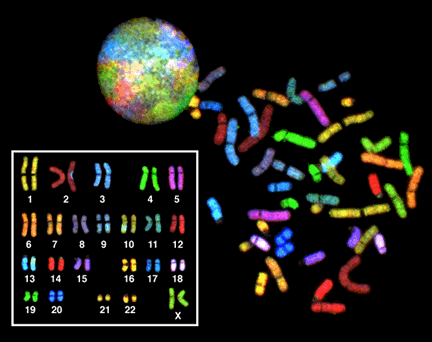
*This web page was produced as an assignment for an undergraduate
course at Davidson College.*
Examples of FISH

Scientists generally us FISH in three different ways: Permission for use of this image is pending and can be accessed at http://www.accessexcellence.org/AB/GG/sky.html.
1) Locus specific probes
These types of probes are useful when a scientist wants to research a particular region of a chromosome. For example, a scientist knows the sequence of a gene, but does not know on which chromosome the gene is located. In this case, the scientist would prepare a probe from the known gene sequence and observe which chromosome the probe binds to.
2) Centromeric repeat probes
These types of probes are obtained from repetitive sequences found at the centromeres of chromosomes. Scientists use this probe to determine whether or not an individual possesses the correct number of chromosomes. Each probe is painted with a different color to distinguish between the chromosomes. Centromeric repeat probes are also ideal for the identification of the origin of small marker chromosomes.
3) Whole chromosome probes
These types of probes are actually
a collection of probes that bind to different parts of a chromosome. As
a result of the probes binding to different sequences all over the chromosome,
a spectral karyotype is formed. The chromosomes can now be differentiated
between based on their range and location of colors. This abiltiy to differentiate
between chromosomes allows scientists to confirm translocations, identify cryptic
rearrangements and identify euchromatin in marker chromosomes. Scientists
identifying cryptic rearrangements is important because it enables scientists
to detect some of the specific chromosome rearrangements seen in certain cancers,
allowing for an early and accurate cancer diagnosis in patients.
What is in the future for FISH?
Davidson College Molecular Biology Homepage
Send questions or comments to brstonestreet@davidson.edu